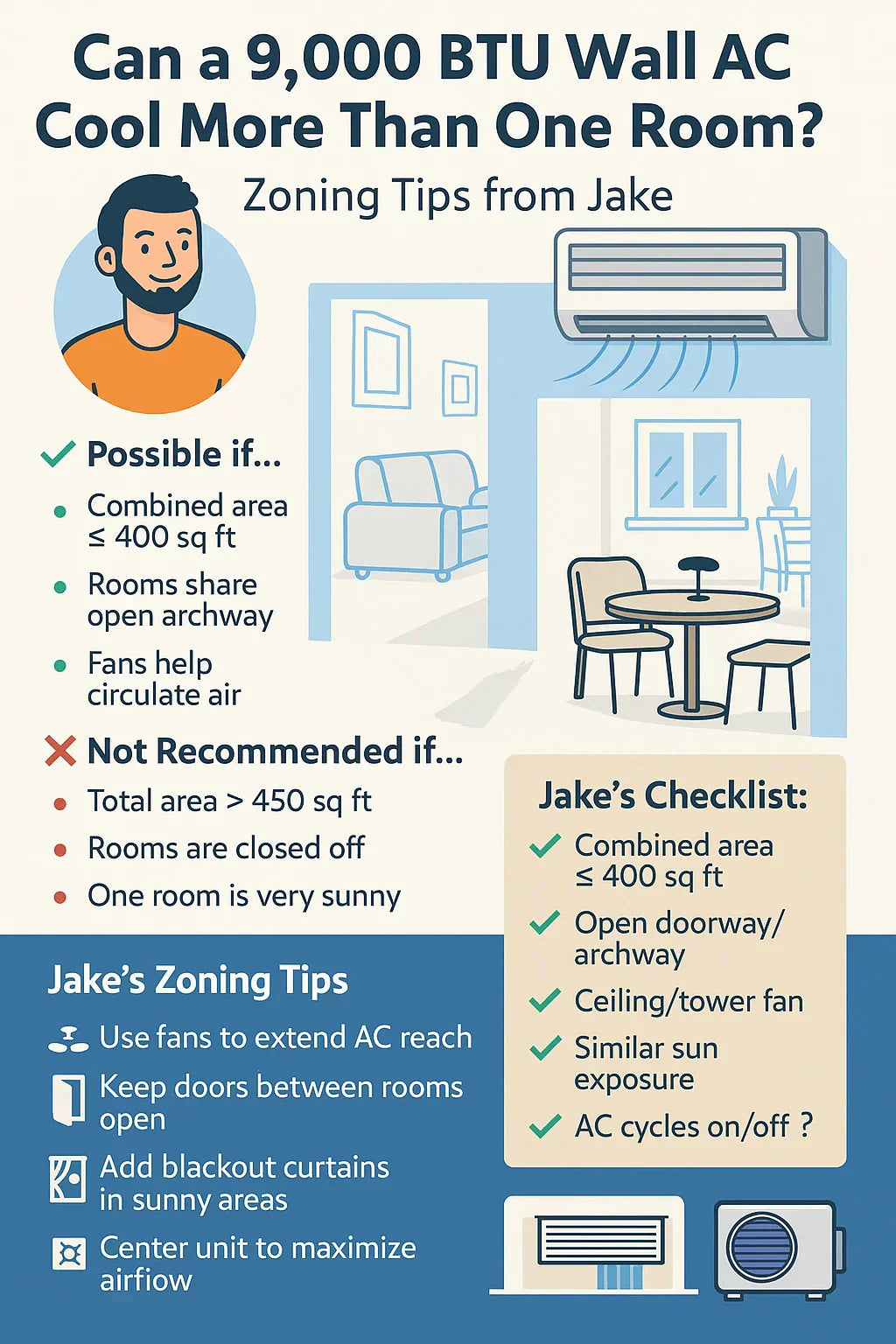🌬 Introduction
Jake had a problem. His 9,000 BTU through‑the‑wall air conditioner kept his living room perfectly cool, but his dining room—just on the other side of an open archway—was always a few degrees warmer. He wondered:
👉 Could one wall AC keep both spaces comfortable?
Like many homeowners, Jake wanted to stretch the value of his AC investment without overspending on another unit. But he also didn’t want to run the system into the ground by overworking it.
In this guide, Jake explores whether a 9,000 BTU wall AC can cool more than one room, the conditions where it works, and the zoning strategies that make it possible.
📏 Understanding the Cooling Capacity of a 9,000 BTU AC
🔎 The Basics of BTU Ratings
-
BTU stands for British Thermal Units—a measure of cooling power.
-
Rule of thumb: 20 BTUs per square foot (PickHVAC).
📊 Coverage Area
-
6,000 BTU → 150–250 sq ft
-
8,000 BTU → 250–350 sq ft
-
9,000 BTU → 350–400 sq ft
Jake’s living + dining area together measured ~380 sq ft. On paper, a 9,000 BTU unit was just enough.
⚡ Factors That Affect Real-World Cooling
Jake quickly learned that square footage is only part of the story. Other factors matter:
-
Ceiling Height: Higher than 8 feet? You need more BTUs.
-
Sun Exposure: South‑ and west‑facing rooms gain more heat.
-
Insulation Quality: Drafty windows or thin walls mean more cooling load.
-
Layout: Open floor plans = better airflow. Narrow hallways = poor distribution.
📌 Energy Star notes that poorly insulated or sunny rooms may need 10–20% more BTUs.
🛠 Can a 9,000 BTU Wall AC Handle Two Rooms?
Jake tested his setup and kept a thermometer in both rooms. Here’s what he found.
✅ Yes, If:
-
Combined area ≤ 400 sq ft
-
Rooms share a wide archway or double door
-
Fans help push air across
-
Both rooms have similar sun exposure
Jake’s living + dining combo: 380 sq ft, open archway, one ceiling fan → result: 74°F in living room, 76°F in dining room. Comfortable.
❌ No, If:
-
Combined area > 450 sq ft
-
Rooms separated by narrow halls or closed doors
-
One room gets significantly more sunlight/heat gain
-
Unit runs constantly but still doesn’t hit target temp
In his neighbor’s house, a 9k unit in the living room couldn’t cool the adjacent 200 sq ft kitchen with southern exposure. Result: AC ran nonstop, yet kitchen stayed hot.
🔧 Jake’s Zoning Tips for Better Airflow
Jake turned his borderline setup into a comfortable one using zoning hacks.
💨 Fans Are Your Best Friend
-
Ceiling Fans: Circulate cool air evenly. Run counter‑clockwise in summer.
-
Tower Fans: Placed in doorways, they push cool air into the next room.
-
Box Fans in Windows: Draw hot air out at night to reduce next‑day load.
🚪 Door & Layout Tricks
-
Keep doors open between connected spaces.
-
If privacy needed, consider louvered doors for airflow.
-
Avoid bulky furniture blocking the AC airflow.
🌞 Reduce Heat Load in Both Rooms
-
Blackout curtains reduce solar gain by up to 30% (DOE).
-
Add weatherstripping around doors and windows.
-
Use UV‑reflective window film in sun‑heavy rooms.
📐 Strategic Placement of the Unit
-
Install AC on a wall that’s central to both rooms.
-
Make sure the front vents face the larger space.
-
Keep at least 3 feet clearance from curtains, blinds, or furniture.
📌 Better Homes & Gardens recommends centering AC placement for shared spaces.
💵 Cost & Efficiency Considerations
Jake tracked his energy use with a smart plug to see if cooling two rooms was worth it.
Case Study: Jake’s 9k BTU Unit
-
Power Draw: 850 watts/hour
-
Usage: 8 hours/day in July
-
Monthly Consumption: ~204 kWh
-
Electric Rate: $0.15/kWh → ~$31/month
When cooling both rooms:
-
AC ran longer cycles but still cycled off → cost ~$35/month.
-
Still cheaper than running two separate 6k units (~$50–$55/month combined).
📌 Energy Star confirms that one efficient unit can be cheaper than two smaller, less efficient units—but only if within rated coverage.
🏡 Alternatives for Multi-Room Cooling
Jake explored other solutions for bigger or more complex layouts.
❄ Mini Split Systems
-
Ductless systems with zoned air handlers.
-
Perfect for 2–5 rooms.
-
Higher upfront cost ($3,000+), but highly efficient.
🔥 Hybrid Solutions
-
Pair your wall AC with a dehumidifier: less humidity = cooler feel.
-
Add portable ACs in peak heat for backup.
🛠 Add Another Wall Unit
-
Two 6,000 BTU units may outperform one 12,000 BTU in spread‑out rooms.
-
Better redundancy: if one fails, you still have cooling.
📌 This Old House advises checking layout before buying one oversized unit.
✅ Jake’s Checklist: Can My 9,000 BTU Wall AC Cool Two Rooms?
-
Combined area ≤ 400 sq ft
-
Rooms connected by open archway/doorway
-
Ceiling or tower fans in place
-
Sun exposure roughly equal
-
AC cycles off (not constantly running)
If most boxes are checked → You’re good to go.
If not → Add fans, reduce heat load, or consider a second unit.
🏁 Conclusion
Jake’s takeaway:
-
Yes, a 9,000 BTU wall AC can cool more than one room—if the rooms are small, open, and together under ~400 sq ft.
-
No, if you’re asking it to do the work of a multi‑zone system or fight bad insulation.
-
With fans, smart placement, and heat‑load reduction, Jake made his single unit keep both living and dining rooms comfortable—saving money compared to buying a second system.
For Jake, the experiment paid off. But if your space is larger or more closed off, a mini split or second wall AC may be the smarter move.
In the next topic we will know more about: Maintenance Tips for Your 6,000–9,000 BTU Through-the-Wall AC







